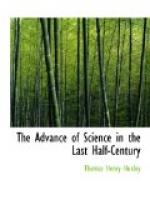That light exerts a remarkable influence in bringing about certain chemical combinations and decompositions was well known fifty years ago, and various more or less successful attempts to produce permanent pictures, by the help of that knowledge, had already been made. It was not till 1839, however, that practical success was obtained; but the ‘daguerreotypes’ were both cumbrous and costly, and photography would never have attained its present important development had not the progress of invention substituted paper and glass for the silvered plates then in use. It is not my affair to dwell upon the practical application of the photography of the present day, but it is germane to my purpose to remark that it has furnished a most valuable accessory to the methods of recording motions and lapse of time already in existence. In the hands of the astronomer and the meteorologist, it has yielded means of registering terrestrial, solar, planetary, and stellar phenomena, independent of the sources of error attendant on ordinary observation; in the hands of the physicist, not only does it record spectroscopic phenomena with unsurpassable ease and precision, but it has revealed the existence of rays having powerful chemical energy, or beyond the visible limits of either end of the spectrum; while, to the naturalist, it furnishes the means by which the forms of many highly complicated objects may be represented, without that possibility of error which is inherent in the work of the draughtsman. In fact, in many cases, the stern impartiality of photography is an objection to its employment: it makes no distinction between the important and the unimportant; and hence photographs of dissections, for example, are rarely so useful as the work of a draughtsman who is at once accurate and intelligent.
[Sidenote: Astronomy,]
The determination of the existence of a new planet, Neptune, far beyond the previously known bounds of the solar system, by mathematical deduction from the facts of perturbation; and the immediate confirmation of that determination, in the year 1846, by observers who turned their telescopes into the part of the heavens indicated as its place, constitute a remarkable testimony of nature to the validity of the principles of the astronomy of our time. In addition, so many new asteroids have been added to those which were already known to circulate in the place which theoretically should be occupied by a planet, between Mars and Jupiter, that their number now amounts to between two and three hundred. I have already alluded to the extension of our knowledge of the nature of the heavenly bodies by the employment of spectroscopy. It has not only thrown wonderful light upon the physical and chemical constitution of the sun, fixed stars, and nebulae, and comets, but it holds out a prospect of obtaining definite evidence as to the nature of our so-called elementary bodies.
[Sidenote: its relation to geology.]




